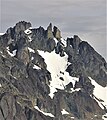Mount Johnson (Washington)
History
Mount Johnson was given its name based on what was believed to be the first ascent by Elvin Johnson and George Martin in 1940. However, new evidence has become available establishing that it was climbed by Scott Osborn, Joe Halwax, and John King circa 1935.
Climate
Mount Johnson is located in the marine west coast climate zone of western North America. Weather fronts originating in the Pacific Ocean travel northeast toward the Olympic Mountains. As fronts approach, they are forced upward by the peaks (orographic lift), causing them to drop their moisture in the form of rain or snow. As a result, the Olympics experience high precipitation, especially during the winter months in the form of snowfall. Because of maritime influence, snow tends to be wet and heavy, resulting in avalanche danger. During winter months weather is usually cloudy, but due to high pressure systems over the Pacific Ocean that intensify during summer months, there is often little or no cloud cover during the summer. The months July through September offer the most favorable weather for viewing or climbing this peak.
Recreation
While not a particularly technical climb, Mount Johnson is a steep and exposed class 4 scramble. It's one of several mountaineering objectives in the Royal Basin area.
Gallery
References
- ^ "Mount Johnson". Peakbagger.com. Retrieved October 10, 2019.
- ^ ""Mount Johnson" - 7,700' WA". listsofjohn.com. Retrieved June 17, 2020.
- ^ Parratt, Smitty (1984). Gods and Goblins: A Field Guide to Place Names of Olympic National Park (1st ed.).
- ^ Peel, M. C.; Finlayson, B. L.; McMahon, T. A. (2007). "Updated world map of the Köppen−Geiger climate classification". Hydrol. Earth Syst. Sci. 11: 1633–1644. ISSN 1027-5606.
- ^ McNulty, Tim (2009). Olympic National Park: A Natural History. Seattle, Washington: University of Washington Press.
- ^ Mount Johnson, climbersguideolympics.com
External links
- "Olympic National Park". National Park Service.
- Mount Johnson photo: Flickr



